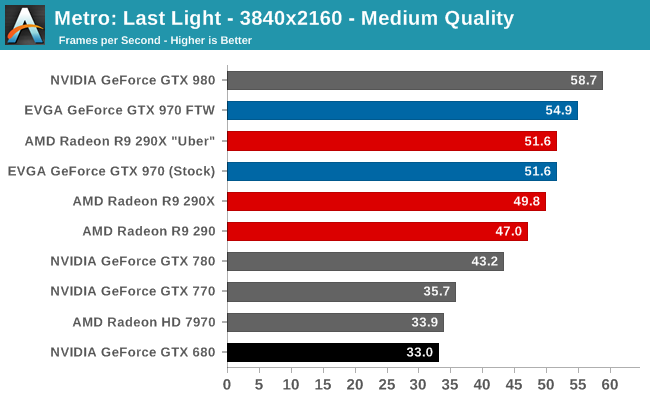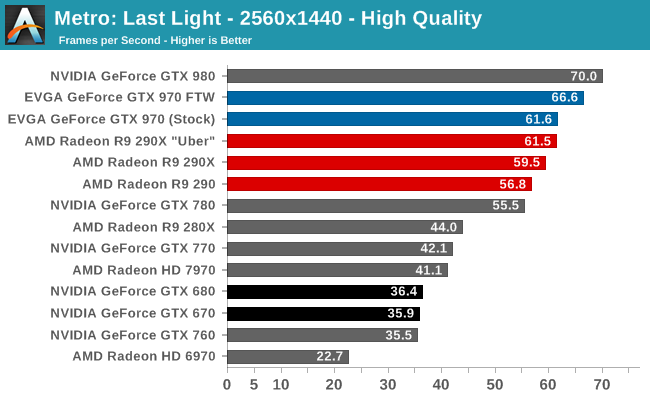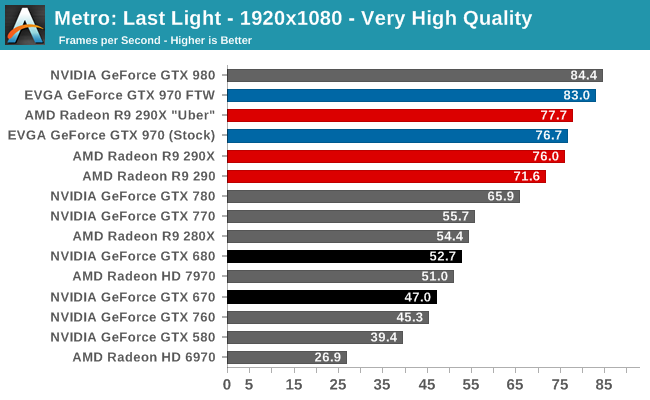The NVIDIA GeForce GTX 970 Review: Featuring EVGA
by Ryan Smith on September 26, 2014 10:00 AM ESTMetro: Last Light
As always, kicking off our look at performance is 4A Games’ latest entry in their Metro series of subterranean shooters, Metro: Last Light. The original Metro: 2033 was a graphically punishing game for its time and Metro: Last Light is in its own right too. On the other hand it scales well with resolution and quality settings, so it’s still playable on lower end hardware.



It seems fitting that we start with a game where the GTX 970 and R9 290XU start out tied. Even at the R9 290XU’s strongest hand – 4K – the GTX 970 is at parity and that remains for 1440p as well. Only at 1080p does the GTX 970 even begin to trail the R9 290XU.
This game ends up being a very good summary of what we’re going to see. The GTX 970 and R9 290XU trade blows from game-to-game, but in the end the two are a tie, just as we see here. Which for NVIDIA is a great outcome, as it means they’re tying a card that's nearly 50% more expensive.
Meanwhile if we push on the gas pedal a bit harder with the GTX 970 FTW, we see the EVGA card pull ahead of the R9 290XU and stock GTX 970 by 8%. This is a bit above average overall for the GTX 970 FTW, but it does conveniently highlight the fact that even if AMD officially pushed the clock speeds of R9 290XU a bit more, they’d still end up with GTX 970 right next to them.










155 Comments
View All Comments
AnnonymousCoward - Sunday, September 28, 2014 - link
So you're saying it doesn't matter to say "clocked at 7GHz" when the actual clock is 1.75GHz. Well it matters to me! What if the chip multiplies the core clock by 2 internally; should we then say the core clock is 2.2GHz instead of 1.1GHz?Black Obsidian - Monday, September 29, 2014 - link
And thus the reporting of EFFECTIVE clock speeds. Not everyone does (or can) understand the complexities of the underlying architecture.jtrdfw - Wednesday, September 30, 2015 - link
yes. heatsinks on memory are pretty much a scamMagickMan - Friday, September 26, 2014 - link
How about a 970 OC vs 290 OC comparison? I don't have a favored GPU, I just care about bang for buck.The_Assimilator - Friday, September 26, 2014 - link
What would be the point? 970 already equals or beats 290X, and you don't get much from overclocking Hawaii GPUs, apart from more heat.poohbear - Friday, September 26, 2014 - link
Thank u for including a full stable of previous gen video cards to compare it to! In particularly the 670 & 770! Gives us a better idea of how it performs!Tetracycloide - Friday, September 26, 2014 - link
Seconded. Still running a 6950 flashed to 6970 so having the stock 6970 as a point of reference made this the easiest buy ever. Roughly twice the performance with lower power, heat, and noise? Yes.roxamis - Monday, September 29, 2014 - link
I have the same card (Sapphire 6950 Dirt 3, unlocked to 6970) and one fan of the 2 died last week (hitting 90-100 deg C in games). So with that I went to see what i can replace it with and the 970 ticks all my marks.krazyfrog - Friday, September 26, 2014 - link
The price-to-performance ratio is strong with this one.Frenetic Pony - Friday, September 26, 2014 - link
Certainly, but considering AMD has implemented some of the same things I'd expect an equivalent price to performance ratio from AMD for their new cards. Cut down the 290's bus to 256bit, clock the ram to 7ghz, and with the bandwidth compression you'd get a cheaper card with the same performance.Still, nice all around to have choices, been looking at cards myself, and am going to build a system for my brother quite soon. Yay price wars!